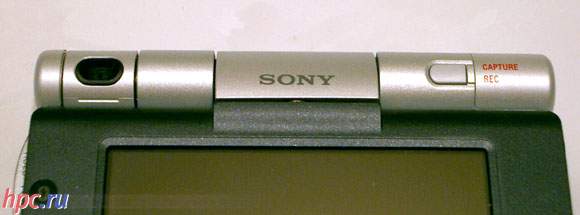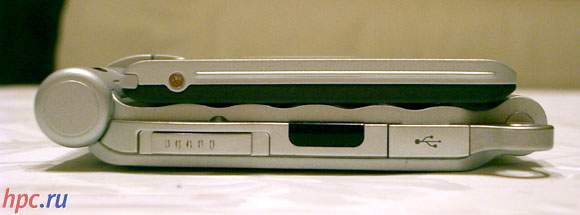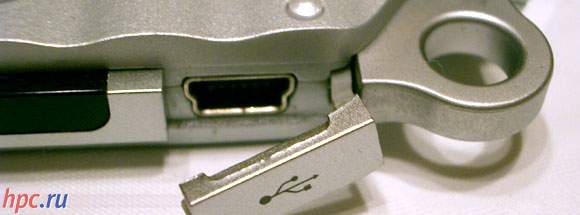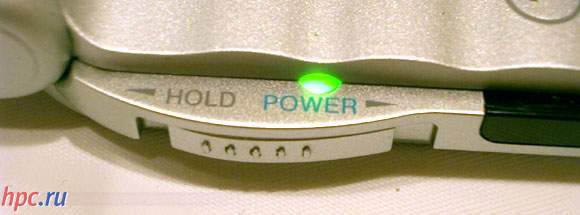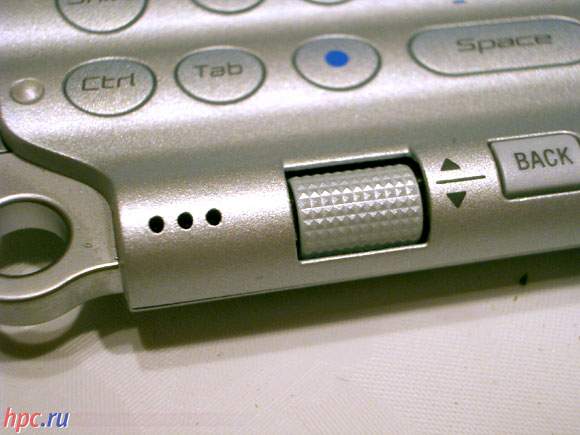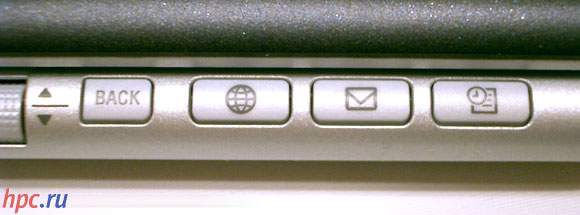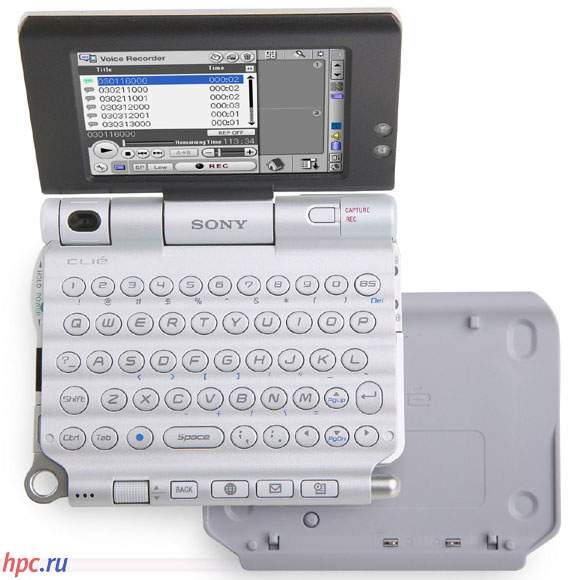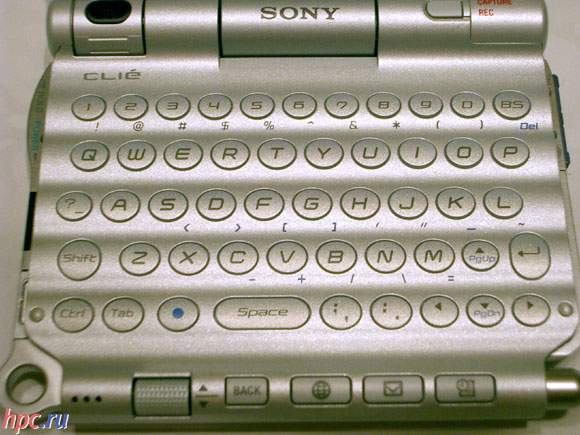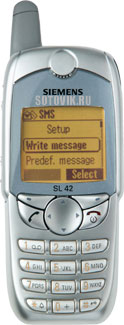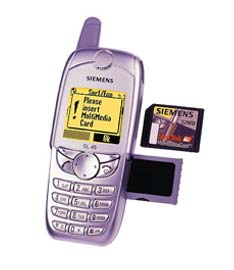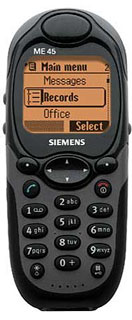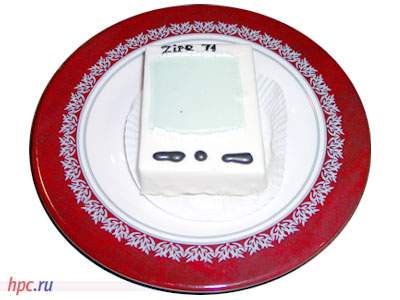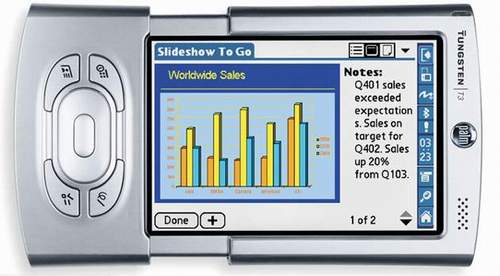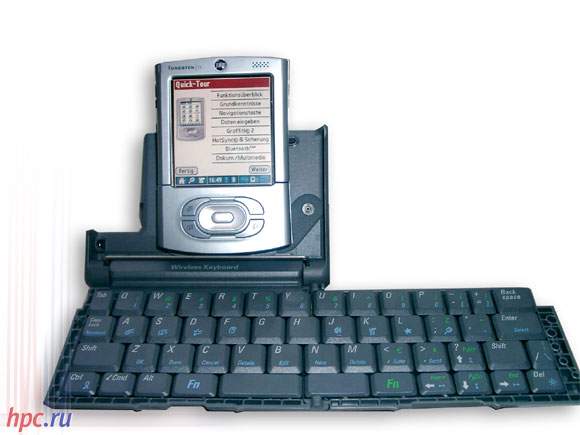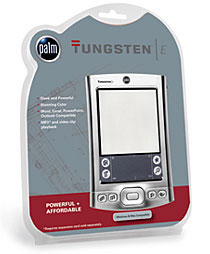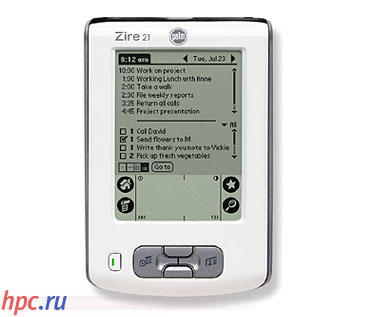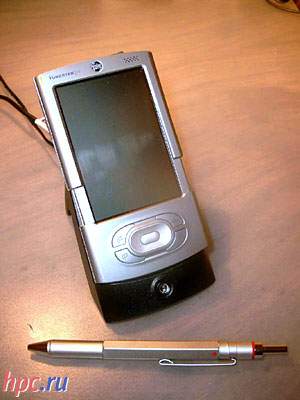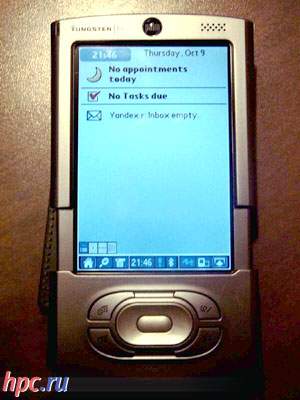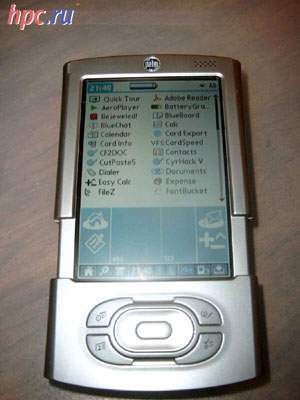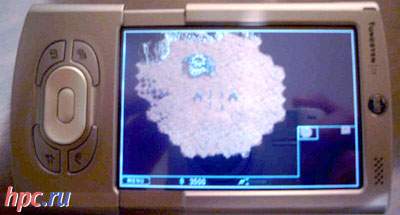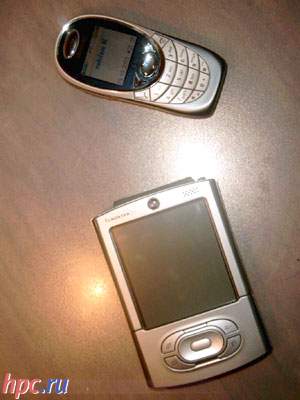This review will discuss the model Clie PEG UX50, which we have for your convenience we will call simply UX50. In addition, Sony has released a handheld and a younger series UX, which was named UX40 and differs from his older "brother" only the absence of built-in Wi-Fi and, accordingly, has a lower cost. Therefore, all underwritten, except for Wi-Fi module, applies to the UX40. Sony's flagship handheld embodies several "know-how, fundamentally different from this handheld models and competitors: it is the original foldable design with a horizontal screen, and the proprietary CPU with a variable clock frequency, and a special memory module, divided into several sectors. In addition, Clie UX50 is equipped with a digital camera and with two wireless modules. Experts reputable site PalmInfoCenter one of the first shared their impressions of this handheld in a strictly systematic manner, starting from design and ending with a description of the battery. We decided to add their own comments page, and even individual small cupola, which the text will be bold.
Design
The first thing that you pay attention, picking up a computer Clie UX50, - is its compact size. Photos, unfortunately, can not convey how much is actually a miniature device. Its dimensions - 103x86, 5x 17,9 mm, the machine is slightly larger than the Palm Tungsten T, but successful ergonomic shape makes it visually less. Yes, and the weight is also quite acceptable for a model with a bunch of "bloat" - only 175 g, so that the CCP is really suitable for carrying in your pocket.
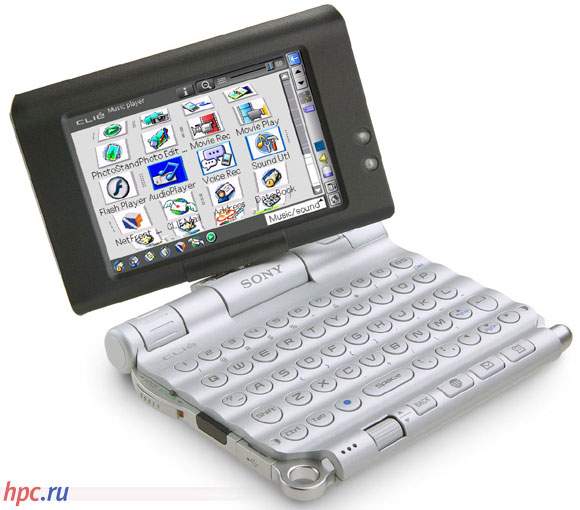 |
If you compare him to the handheld with the previous models, then Decrease the weight up to 175 g really seem to achieve. Remember, the latest hi-end PDAs: NX80V tugged at 235 g, and the golden brick »NZ90 - all 292 should be noted that the materials from which made housing, also well-matched. Both the top and bottom halves of the folding model are made, apparently, from lightweight magnesium alloy. This decision, in addition to more than the plastic strength, has another advantage: the surfaces are made very smooth, but they did not leave any fingerprints or scratches.
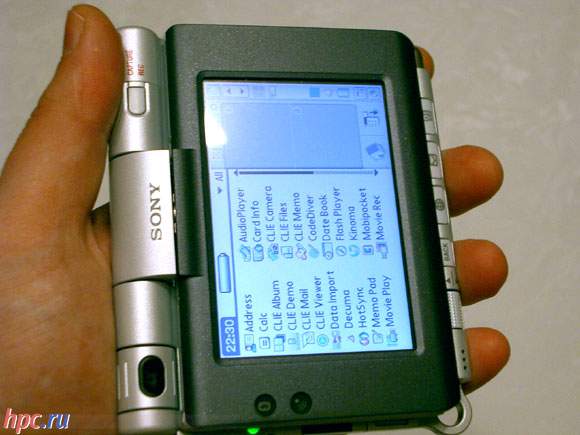 |
The new form factor, which went Clie UX50, users have already dubbed a "mini-notebook, although its design makes it possible to operate in the traditional tablet mode (the screen is set at 180 degrees and rests over the keyboard). However, in the folded GUI PDA still continues to operate in the "horizontal" orientation, which is somewhat difficult to work. Right of the display there are two LEDs that inform about connection over radio Bluetooth and Wi-Fi. Around the display has a wide enough frame on which to place the application launchers. On the left "the fold," the handheld has a built in digital camera on the hinge, and there is right - the key shooting and naushnikovy output.
On the left side of the PDA is two-color LED illuminates when the device and move into a mode of recharging batteries.
Near - infrared port connector and a mini-USB, closed cap (synchronization with your desktop PC is only through him, as the cradle only brings food).
Interestingly done the power button, combined with the button "hold". A sort of semi-circular lever with small protrusions, very conveniently falls under the thumb of his left hand, and looks pretty. In contrast to recent computers manufactured by Palm Inc. (Starting with the Zire 71), light displays, which will not turn off the screen at the UX50 can be turned off in the traditional way, by pulling the lever for food and keeping it in such a position a few seconds.
In the lower left corner of the device has a large metal ring, intended, apparently, to using the rifle to wear a PDA to your belt or hang on the neck. Apparently, in Japan, so are ...
Right next to the ring on the "facade" of the device is a microphone, and right - Jog Dial, Back button and three shortcut keys to launch programs (web-browser, mail-client and calendar). In the lower right corner is placed a silo. It must be noted that the mere "pen" as it is now accepted at Sony, like the size of a toothpick. In general, very thin and uncomfortable.
The buttons, of course, flash, and you can "adjust" them under running any suitable applications. I recommend one of the keys to designate responsible for the operation synchronizing with a desktop computer.
On the right side is a slot for expansion cards, Memory Stick format for all versions (just MemoryStick, MagicGate MemoryStick, MemoryStick Duo and MemoryStick PRO). Slots for CF cards, unfortunately, no. Directly above the slot has two LEDs. The one on the right, is illuminated when the tape recorder running or recorded video, but one that left, flashes orange when accessing the card MemoryStick. It should be noted that pull the card from the connector - not so easy. No longer enough to simply click on the flash drive. It is necessary, moreover, with great effort to pull it towards you. So, if you accidentally push the card during operation, do not worry - do not fall out and not get lost:)
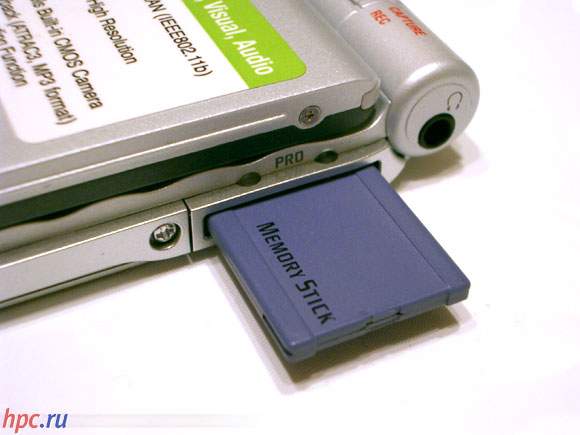 |
To the left of the slot MemoryStick can see a small cog in the battery compartment.I hasten to disappoint you, the battery is not removable, and unscrew the screw, this is only recommended if the battery fails. But on the battery and the time of its battery life - just below. The rear panel contains the elements of attachment and contacts for connection to the cradle or optional battery, speaker and reset button. By the way, a soft button rezet all developers have to say a special thank you from Sony. You know why? - Because it is - a big one. Now for the product of this procedure does not need to unscrew the stylus, since it will fit perfectly sharpened end. I would not say that in the process of testing the computer had often overloaded, but agree that in those moments when you need to do is unscrew the stylus or frantically search for a thin pin does not want.
Cradle
In the model UX50 Sony launched a new concept of cradle: now or on a Pocket PC or on the "crib" no HotSync connector. On the computer there is only a miniUSB, and on the cradle - a power socket. But because the computer is equipped with a wireless module - Wi-Fi and Bluetooth, the use of peripherals and synchronization can be done without wires.
Keyboard
Clie UX50 was the largest among the QWERTY keyboard handhelds Sony, and because of such size to use it quite comfortably.
As well as on a normal desktop keyboard, on top of it posted a series of numbers, lower - the three "lines of letters, and underneath a large space surrounded by official buttons. In poor light conditions to work on the keyboard is quite possible - the good, the orange light is disconnected. To save energy, it will turn off automatically after 10 seconds of "downtime."
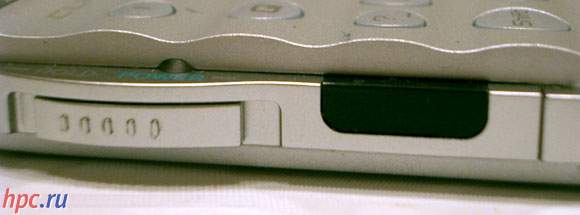 |
The keys are made quite large, nearly eliminates the possibility of accidentally pressing two adjacent keys at once. The fact that the series of keys in waves rise significantly helps with touch-typing, but the buttons are placed flush with the body and the relatively weak spring loaded, and this, in contrast, interferes. Under the "blind stamped on the Sony UX50" the review authors seem to imply a fast printing with the thumbs of both hands (with the keyboard at a sufficiently high dexterity can not really look), but not desyatipaltsevym method. Unfortunately, the user interface Clie UX50 not adapted to navigation by keyboard. Moreover, when working with dialog boxes have now and then pull out the stylus and intercept the handheld, but even the arrow keys in this PDA only virtual. It is not just inconvenient. Functional model sharply narrowed, as the majority palmovyh games that used to control navigation button D-Pad, are incompatible with the Clie UX50.
Processor
Functions of a central processor Clie UX50 does a brand new chip Handheld Engine, developed by the firm Sony. Its uniqueness lies in the dynamic change of clock frequency, depending on your needs. That is, when performing intensive tasks "stone" can accelerate to 123 MHz, while in standby mode, "speed" drop (at least 8 MHz). The processor is based on the ARM926 core and is equipped with additional chips - CXD2230GA for graphics hardware acceleration (with support for 3D-akselleratsii OpenGL) and Digital Signal Processor (DSP) for audio processing.Basic performance tests showed that the possibility of system resources Clie UX50 are roughly equivalent in power "hardware" model Clie, based on the 200-MHz processor XScale. None of the games was not noticed "brakes", and parallel playback of MP3-files and viewing web-pages of wireless Wi-Fi did not reveal any delays or disruptions. Unfortunately, our colleagues will not give test results, and not even known programs through which the test PDA. Our experience has shown that using a purely synthetic test (eg, utilities, Benchmark 2.0) is not suitable for measuring the performance of your computer with a "floating" clock speed. It seems that the processor does not consider the test task requires all of its power and strains "pebble" is not the full program. Something similar occurs when using the synthetic utilities are trying to measure the productivity of Pocket PC in the automatic mode. So, let's see how our results differ from those of foreign colleagues. Indeed, when working with PIM and office applications are no "brakes" did not notice. A performance of video playback UX50 even surpassed cvoego sharper youngest family member - NX80V - yet not in vain hardware graphics accelerator installed:) It is true that video playback from the Internal Media (in the table are marked with int.), A noticeable decrease in performance, and computer has already lost the same 200MHz-vomu brother.
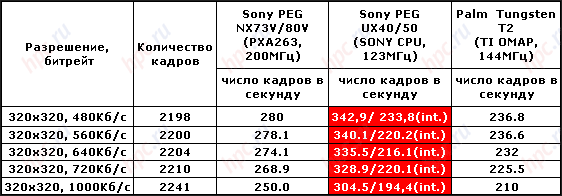 |
Despite this small misstep, the whole approach to designing their Sony handheld inspires great respect, and for this reason. Why put the powerful and expensive Intel-ovsky processor if you can create your own, simpler and cheaper and provide him with special accelerators for audio and video ...?
Memory
Storage devices that are received, this model is also very unusual. Memory of "physically" is divided into several sectors: 16 MB set aside for loading programs and files, an additional 16 MB - for dynamic paging (swap), an additional non-volatile block the same amount set aside to back up system data, and an additional 29 MB are essentially built flash card, with which the handheld plays MP3-music and video clips. At first glance, the total amount of memory a pleasant surprise - on board, UX50 stored 104Mb. But if you look, it actually available to the user of them not so much. The memory is organized as follows. The processor has 8MB of built-in operating memory types SDRAM. In addition, there is a classic in the form of RAM 32MB of SDRAM, of which nick owes exactly half - 16 MB. In the handheld and the installer application, it is called Handheld.
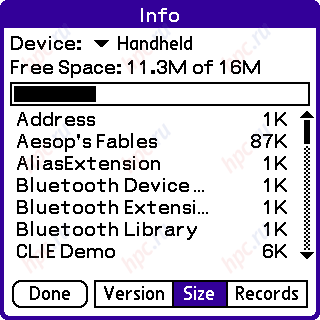 |
Next comes the 64MB chip NAND FLASH, performing the role of ROM. For the user, available in two of its area - to 16MB of storage backup system and 30.2 Mb, which form the region, works as a built in card Memory Stick. Last sharpened by working with Sony branded applications for recording and playback of audio, video and photo viewing.
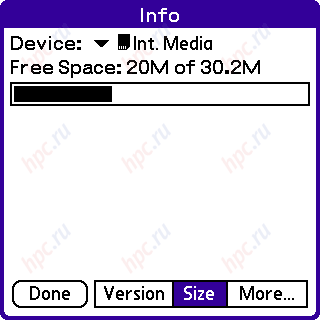 |
In naladonike and installer applications, these are called 30.2 MB Internal Media. Works, this memory is slower than RAM, but faster than the external card MemoryStick. Curiously, this chip is a fully-volatile, that is, if you suddenly sit the battery, the data contained in it, will not be lost.Now, about 16 MB of ROM, intended for backup. Pocket PC usually has a special power saving mode (Preferences / Power Saving): even if the handheld is turned off, the RAM chip is still continues to consume battery power in order to not "lose" the stored data. If you are not long enough to use your PDA, then the battery will sit down gradually, and the CCP will lose all information in the RAM information. Therefore, when you are not using your computer, it is recommended to perform the following procedure. After selecting the power saving mode automatically makes your computer saving a backup copy of all data from 16MB RAM to 16MB of ROM and power on / off. The copying process takes an average of 30 seconds, depending on the amount of used RAM. After turning on the backup is brought back into RAM (the process takes seconds to 15), and your computer is ready for use again. Power-saving mode allows you to save energy when your computer is not working, taking you for a total of about a minute on backup and recovery. The only pity is that the Sony UX50, in contrast to handhelds based on Pocket PC, not the automatic backup in the event that the computer's power reaches a critically low value. However, to make BackUp - question a couple of minutes, and personal organization. To summarize this chapter: just as a result of subtracting the various Pocket PC user needs to share from the existing 104Mb-volume is 62.2Mb of memory. Agree to Palm'a - very nice ...
Screen
Display, inherited this machine belongs to the highest class. TFT-matrix 480 x 320 pixels, capable of displaying 65 thousand colors, subjectively perceived as being much more clear and quality compared to other screens with similar characteristics. This is because of this display area is somewhat less of others, and therefore the pixels "planted" a much denser. You can be happy and very flat illumination of the matrix, and sufficient brightness. Inside the image looks just fine and not so much fade on the street in bright sunshine. Brightness is that sufficient. Apparently, in order to reduce the total cost of the handheld manufacturers found less bright backlight. The maximum brightness of the display at the HP iPAQ h2210, that one and a half times lower than the previous model NX80V. Now for the contrast. Dims is apparently a tribute to tradition and the desire to distinguish themselves from competitors. The fact that the Pocket PC from Palm, for example, have a minimum brightness level at which the PDA to work comfortably. In my opinion, it is more correct approach. The fact is that when the illumination is to receive the information from the PDA is quite difficult. At least, when reading the text, you can easily "break the eyes, and a Sony UX50 it off in less than a minute. However, even at minimum brightness all in perfect order. True, in contact with direct sunlight the display is still recommended to put lights on the 5-8th division. Diagonal size of the new display costavlyaet only 3,2 ', as compared to the 3.8 "at NX80V lower by 27%. Display size decreased, but the resolution remains the same. In the "square" mode, when the resolution is 320x320 pixels, the screen becomes very small. Frankly, the display size is too small, and the picture is composed of very tiny pixels, it looks strange. As already mentioned, the screen has two "open" position: it can be located, the display is a laptop, or it can be put upside down at the keyboard, so that the CCP will look like a standard "besklaviaturny" handheld - or rather, a miniature tablet PC. But even in the latter case, the graphical interface of the system can not be set in vertical (portrait) mode. And this gives rise to a number of problems. First, it is not popular with every palmovoy program is convenient to work with horizontal screen (fortunately, Sony redesigned the entire standard set of software for Palm OS based features of "horizontal" work). Secondly, the applications created under the standard display high res +, is simply incompatible with the Clie UX50, and users will have to wait for the issuance of special versions of such software.However, with programs that support the "square display (320 x 320 or 160 x 160), no special problems. The difference comes down to the work that the virtual handwriting area is located right or left of the main window. But probably very soon all the difficulties will be overcome. Let's wait for the Sony release a patch system, which adds ability to rotate the image 90 degrees. Developers, I think, will be offered specifically for the new series of Sony original software interface that take advantage of the "mini-notebook." Part of the proprietary software going to drive Sony UX50 (Netfront, Flash Player, CLIE Mail and others), is optimized for horizontal screen orientation. But my favorite MobiPocket Reader does not support such a screen, so I had to read the program Palm Reader, is supplied.
Communication capabilities
With the Clie UX50 can use a mobile connection to the World Wide Web is almost constant, no matter where you are. At work or in public places operating "hot-spots", PDA allows you to install high-speed connection to the network protocol Wi-Fi (802.11b), and on the road or at home can access the Internet via cell phone, which communicates with the handheld built-in radio module Bluetooth (v1.1). Built-in Bluetooth module is executed on the standard 1.1 for data transfer and 2.0 standard for energy saving, which means that the transmitter has a relatively low power consumption. Checking the quality of communication has shown even better results Wi-Fi-connected (the radius of coverage and data rate) than the model-rival Palm Tungsten C. I wonder how many Wi-Fi networks (commercial and public) do you know? Known to me can be counted on the fingers of two hands. Yes, many would say, the popularity of wireless networks is growing, and in Moscow they become more and more, but it is not so much as in the U.S. or Europe. However, if you are often in business trips abroad, or simply prefer to relax abroad, working remotely watching the situation, then surely Wi-Fi-module is useful to you. Although, those who do not need it, can draw attention to the younger model - UX40. Web-Browser Netfront 3.0, which comes with Clie UX50, are also very pleased. He not only correctly displays all the GIF-pictures and tables and executes JAVA-scripts, but also very effectively scales the sites. As can be seen in the illustration, web page PalmInfoCenter before us almost in the same form as on a desktop PC and is devoid of awkward horizontal scrolling, which sin many "pocket" browsers.
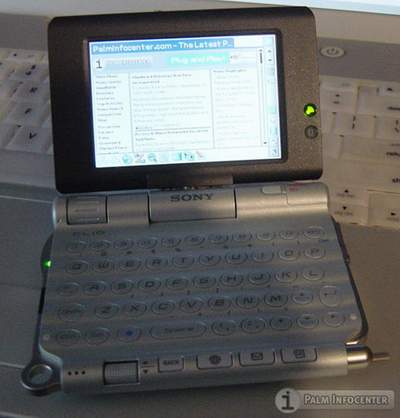 |
Luggage
Digital camera that is equipped with this PDA is pretty standard features for the built-in cameras: 0.3-megapixel sensor, which has a three-time digital zoom (zoom) and allows you to capture a maximum resolution of 640x480 pixels. Minimum resolution for photographs is 160x120 pixels, there is the possibility of obtaining images with a resolution of 320x480 and 320x240 pixels. In addition, as in virtually all Sony cameras have a mandatory set of filters: black and white, negative, sepia, art, and solar illumination. The camera can adjust the brightness in the range of + / -2 and choose one of four modes of white balance settings. There is a 10-second self-timer. However, communication with the camera "live" has revealed some exceptional qualities, we can call this unit is one of the best. And for clarity, and color reproduction machine will handicap virtually all the cells, which receive the latest smartphones and PDAs, including Palm Zire 71, as well as eloquently frame, made with Clie UX50.
 |
These include praise and videos that machine records in MPEG4, 30 fps co / c, image size - 160x112 pixels. It should be noted that the maximum size of a movie - no more than 60 minutes.
Audio
In the Sony UX50 implemented multitasking when playing music, it is possible to listen to music in the background while reading e-books, documents or doing something more useful.
Battery
New tested less than a week, and during that time it was difficult to draw definitive conclusions about the possibilities of the battery at different load conditions. The average energy battery lasts for 4-5 hours in the most demanding conditions, with frequent use of wireless connectivity and a digital camera. More careful measurement of the battery of the computer yielded the following results.
 |
Frankly, we had high hopes for the automatic control clock speed of the processor. Expect, for example, a record high of battery life in read mode and music playback. We can say that hopes to some extent justified, the battery life at the UX50 in read mode is higher than the NX80V - 6,5 hours vs. 5.5 (with a minimum illumination) and 3.25 to 3 hours (at maximum illumination ). Above, but, frankly, expected more. But playing mp3 (from MemoryStick cards for the display is off) was about 14 hours! Most likely, this figure can be increased if the music files will be written not on the outside of the map, and in the Internal Media. For those who still hold battery life will not be invited to plug the battery-PEGA-ED40, increases the total "stored energy" tripled. Is it worth the $ 120 device.
Software
A few words about the software innovations. UX50 - this is the first Pocket PC from Sony is running the operating system Palm OS 5.2. As a system of handwritten input can be used Graffiti2, though without the possibility of making a record in any of the display. The text must be entered in a special area of virtual Graffiti, which can accommodate both left and right of the main field. In addition, there is a second handwriting recognition Decuma, which we first saw in the previous models - NX73V/80V. Virtual input area for this system at the bottom of the screen, but does not replace an area of graffiti. It would still be reasonable to these input fields used interchangeably, there will be a user to enter text and recognize it with two programs, and to switch between the two recognition systems to make a special switch. Decuma not russified and yet it is not clear whether all will be the Russian version of the system. As for the traditional Graffiti 2 handwriting, with the help of the national containment MacCentre PaPiRus 2003 it is possible to work on a "great and mighty," but more about Russification - just below. Curious and implementation lanchera applications. In addition to the usual shell, there is also a 3D lancher, which looks like a rotating three-wheel, like a slot machine "one-armed bandit." The idea is very interesting and most users will like.
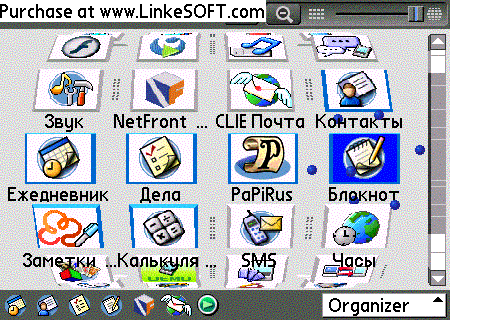 |
A set of software rather extensive and is divided into the following groups.
Proprietary software SONY Clie
- Audio Player
- CLIE Album
- CLIE Camera
- CLIE Demo
- CLIE Mail
- CLIE Memo
- CLIE Viewer
- Flash Player
- Movie Play
- Photo Editor
- Remote Cam - for remote camera control and Voice Rec
- WA Clock
Main Software
- Address
- Date Book
- Memo Pad
- Power One Finance Calc
- Power One Personal Calc
- SMS
- ToDoList
- Calc
Games
System Applications
- Card Info
- HotSync
- Decuma
- Security
- Welcome
- Pref
Utilities
- CLIE Files
- Data Import
- Sound Utilities
Additional software
- Acid Solitaire - Game
- Balance Log
- Palm Reader
- Puzzle Bundle
- Street Finder
- Vindigo
- Net Front 3.0
- Crossword - Game
- Agendus - a popular organizer
- Contacts Pro
- Visto MessageXpress.
In addition, some software is only installed on your PC: - PictureGear Studio
- CLIE Album Plagin - Transfer of albums between handheld and desktop computers
- Image Station library
- Image Converter - software for converting video and audio format PDA
- Giga Pocket Plugin
- Quick Timer 5.0
- Sonic Stage
- CLIE Mail Conduit - Sync Mail Program
- Data Export - Program to transfer data from your desktop computer to a memory card.
Russification
For Russification PDA recommend using a system of national localization MacCentre PaPiRus 2003. Last week came the light-version of the program, which adjusts system settings for your Pocket PC Russia, Russified handwriting and virtual keyboard. In the nearest future development - release the full version for UX-50, providing the translation of the interface for all embedded applications. This crack comes with the Sony UX50, if you get a PDA to a network of shops "The computer in the palm."
Price
During the preparation of this article for publication in a network of shops "The computer in the palm," admitted the youngest model in the new series from Sony - UX40, which differs from the older merely the absence of Wi-Fi-module. Thus, the UX50 can buy for $ 799, and the UX40 - for $ 749.
Conclusions
The results of this rapid test, overall, more than positive. Model Clie UX50, is certainly one of the most advanced PDA on the market. Moreover, it is possible to save money by buying junior modification Clie UX40, differing only in the absence of the module Wi-Fi. Its price was $ 50 lower. From my own experience, that the experiment of turning a handheld computer in mikronoutbuk, Sony is quite a success. High-resolution display 480h320, comfortable keyboard, a relatively large amount of memory (for Palma, of course), the ability to backup the ROM, rich multimedia capabilities, and just two built-in wireless adapter, few people remain indifferent. However, while not all software supports a horizontal arrangement of the screen, and the display itself is too small to be. But knowing the reputation of Sony, I never for a moment doubt that software will soon remake, and the screen will be as large as NX Series, and as usually happens with the products of this Japanese manufacturer - brand-new Pocket PC will find their market:) Sources Materials:


